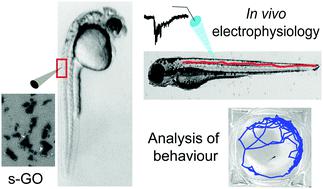当前位置:
X-MOL 学术
›
Nanoscale Horiz.
›
论文详情
Our official English website, www.x-mol.net, welcomes your
feedback! (Note: you will need to create a separate account there.)
Graphene oxide nanosheets modulate spinal glutamatergic transmission and modify locomotor behaviour in an in vivo zebrafish model.
Nanoscale Horizons ( IF 8.0 ) Pub Date : 2020-06-19 , DOI: 10.1039/c9nh00777f Giada Cellot 1 , Sandra Vranic , Yuyoung Shin , Robyn Worsley , Artur Filipe Rodrigues , Cyrill Bussy , Cinzia Casiraghi , Kostas Kostarelos , Jonathan Robert McDearmid
Nanoscale Horizons ( IF 8.0 ) Pub Date : 2020-06-19 , DOI: 10.1039/c9nh00777f Giada Cellot 1 , Sandra Vranic , Yuyoung Shin , Robyn Worsley , Artur Filipe Rodrigues , Cyrill Bussy , Cinzia Casiraghi , Kostas Kostarelos , Jonathan Robert McDearmid
Affiliation

|
Graphene oxide (GO), an oxidised form of graphene, is widely used for biomedical applications, due to its dispersibility in water and simple surface chemistry tunability. In particular, small (less than 500 nm in lateral dimension) and thin (1–3 carbon monolayers) graphene oxide nanosheets (s-GO) have been shown to selectively inhibit glutamatergic transmission in neuronal cultures in vitro and in brain explants obtained from animals injected with the nanomaterial. This raises the exciting prospect that s-GO can be developed as a platform for novel nervous system therapeutics. It has not yet been investigated whether the interference of the nanomaterial with neurotransmission may have a downstream outcome in modulation of behaviour depending specifically on the activation of those synapses. To address this problem we use early stage zebrafish as an in vivo model to study the impact of s-GO on nervous system function. Microinjection of s-GO into the embryonic zebrafish spinal cord selectively reduces the excitatory synaptic transmission of the spinal network, monitored in vivo through patch clamp recordings, without affecting spinal cell survival. This effect is accompanied by a perturbation in the swimming activity of larvae, which is the locomotor behaviour generated by the neuronal network of the spinal cord. Such results indicate that the impact of s-GO on glutamate based neuronal transmission is preserved in vivo and can induce changes in animal behaviour. These findings pave the way for use of s-GO as a modulator of nervous system function.
中文翻译:

氧化石墨烯纳米片在体内斑马鱼模型中调节脊髓谷氨酸能传递并改变运动行为。
氧化石墨烯(GO)是氧化石墨烯的一种形式,由于其在水中的分散性和简单的表面化学可调性,被广泛用于生物医学应用。特别是,较小的(横向尺寸小于500 nm)和较薄的(1-3个碳单层)氧化石墨烯纳米片(s-GO)已显示出可以选择性抑制体外神经元培养物中的谷氨酸能传递。以及从注射了纳米材料的动物获得的脑外植体。这就提出了令人兴奋的前景,即可以将s-GO开发为新型神经系统疗法的平台。尚未研究纳米材料对神经传递的干扰是否可能在行为调节中具有下游结果,具体取决于那些突触的激活。为了解决这个问题,我们使用早期斑马鱼作为体内模型来研究s-GO对神经系统功能的影响。将s-GO显微注射到胚胎斑马鱼脊髓中,可以选择性地减少体内监测的脊髓网络的兴奋性突触传递通过膜片钳录音,而不会影响脊髓细胞的存活。这种作用伴随着幼虫游泳活动的扰动,这是由脊髓神经元网络产生的运动行为。这样的结果表明,s-GO对基于谷氨酸的神经元传递的影响在体内得以保留,并且可以诱导动物行为的改变。这些发现为将s-GO用作神经系统功能的调节剂铺平了道路。
更新日期:2020-07-27
中文翻译:

氧化石墨烯纳米片在体内斑马鱼模型中调节脊髓谷氨酸能传递并改变运动行为。
氧化石墨烯(GO)是氧化石墨烯的一种形式,由于其在水中的分散性和简单的表面化学可调性,被广泛用于生物医学应用。特别是,较小的(横向尺寸小于500 nm)和较薄的(1-3个碳单层)氧化石墨烯纳米片(s-GO)已显示出可以选择性抑制体外神经元培养物中的谷氨酸能传递。以及从注射了纳米材料的动物获得的脑外植体。这就提出了令人兴奋的前景,即可以将s-GO开发为新型神经系统疗法的平台。尚未研究纳米材料对神经传递的干扰是否可能在行为调节中具有下游结果,具体取决于那些突触的激活。为了解决这个问题,我们使用早期斑马鱼作为体内模型来研究s-GO对神经系统功能的影响。将s-GO显微注射到胚胎斑马鱼脊髓中,可以选择性地减少体内监测的脊髓网络的兴奋性突触传递通过膜片钳录音,而不会影响脊髓细胞的存活。这种作用伴随着幼虫游泳活动的扰动,这是由脊髓神经元网络产生的运动行为。这样的结果表明,s-GO对基于谷氨酸的神经元传递的影响在体内得以保留,并且可以诱导动物行为的改变。这些发现为将s-GO用作神经系统功能的调节剂铺平了道路。











































 京公网安备 11010802027423号
京公网安备 11010802027423号